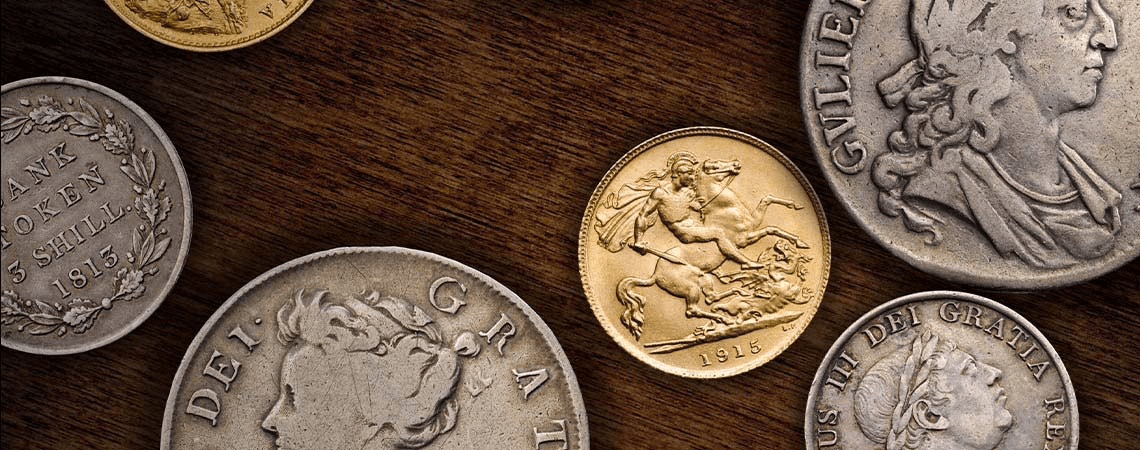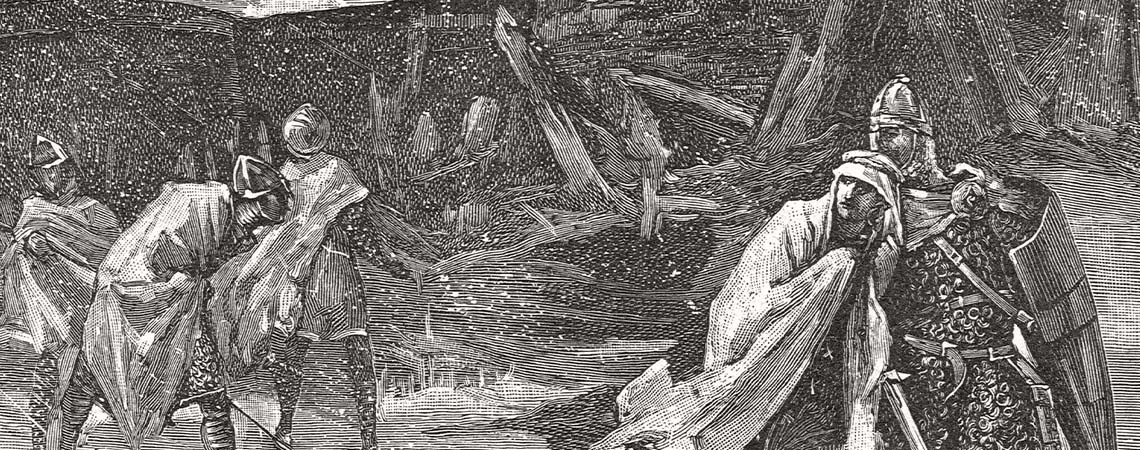
Multiple Mints
In regions beset by war, coin production becomes challenging. Supplies of bullion can dry up, necessitating the use of alternative materials. At the same time, demand for currency can increase dramatically, leaving state mints unable to cope.
New mints must be established or existing facilities moved to follow the course of an itinerant monarch or advancing army. Stability and routine are replaced by improvisation and the sanctity of processes and standards give way to the art of the possible.
Usually, governments keep a tight control over their monopoly to produce currency, and neither the authority to mint or the profits are ever given up easily. But war changes the rules of the game and the weakening of state control can allow a usurper or regional power to assume responsibility for making money. From the Roman invasion to the twenty-first century, this has been evident throughout British history.
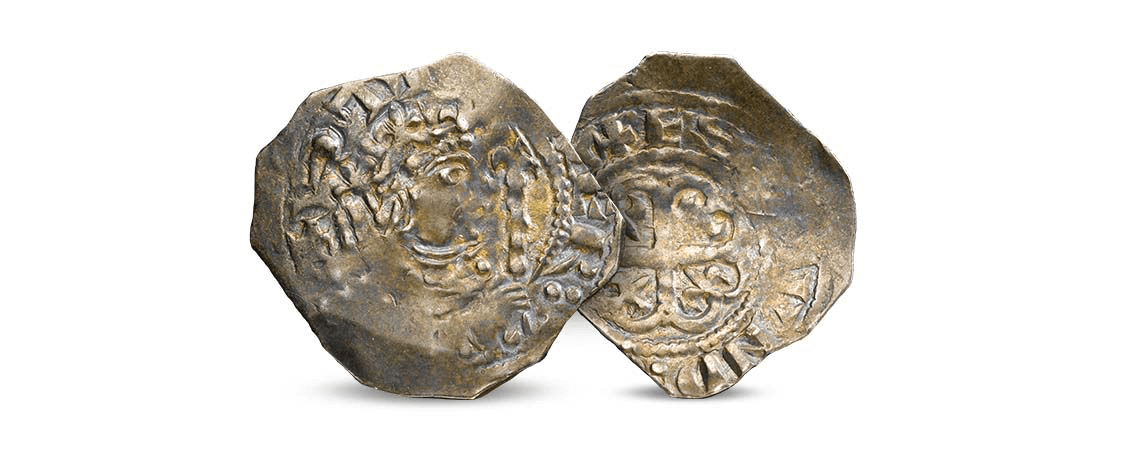
Stephen and Matilda
During King Stephen’s reign (1135–54), England was blighted by civil war. The country was divided between those areas loyal to the king and those supporting his opponents who had pledged allegiance to his cousin Empress Matilda, mostly in the west of England and Wales.
In twelfth-century England there was a well-established network of regional mints overseen from the centre. During this time of unrest, coins were issued in the name of Matilda, as well as under the authority of several of her supporters.
This fragmentation in monetary control was reflected in the quality of the coins emanating from regional mints, which were often poorly struck or underweight, and the production of pieces from defaced dies of King Stephen’s official coinage spoke out as an act of defiance. A national coinage system was restored after the settlement of the civil war in 1153, but the episode demonstrates how keenly the right to mint is seized when opportunity arises.
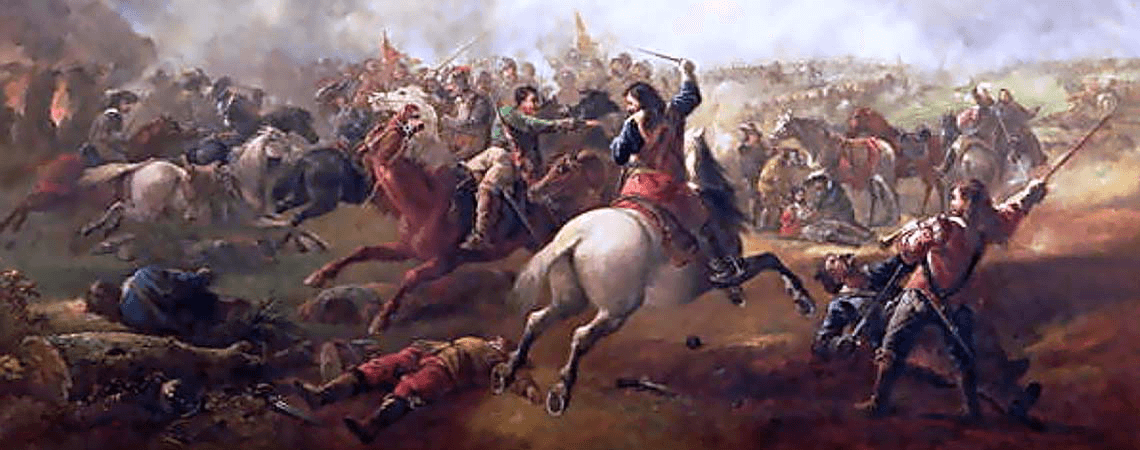
English Civil War
The English Civil War (1642–51) fractured the system once again. Fearing for the safety of his family and retinue as tension with parliament ratcheted, Charles I left London on 10 January 1642. The Royal Mint was housed within the Tower of London and remained under parliamentary control along with the south coast ports. Denied access to the mint and supplies of imported gold, forces loyal to Charles I established their own means of production, striking oversized silver pound coins of equivalent value to their gold counterparts.
The Royalists had a head start as there was already a mint in Aberystwyth prior to the civil war. In September 1642, its equipment was transferred to Shrewsbury, where a mint was established in connection with the recruitment of soldiers for the king’s army.
Royalist mints were subsequently set up in Oxford, Bristol, Truro, Exeter, York and Chester. Besieged towns contributed silver plate which was turned into coins using hand striking techniques, similar to those at the Tower. Many were poorly produced but as a series their quality holds up given their temporary nature.
Branch Mints
Starting in Sydney in 1855, branch mints around the world struck Sovereigns in countries where gold was mined. Production would carry on until 1932, when the Pretoria mint struck the last of these coins. Unlike Canada, South Africa and Australia, India did not experience a gold rush of its own. But, because of naval blockades during the First World War, gold bound for London from South Africa was diverted to the region.
Consequently, during 1918 the branch mint in Bombay struck its own Sovereigns. The distinctive ‘I’ mint mark identifies their origin. They were only produced for one year and they carry the date of the final year of the war. Some of the Sovereigns struck in Bombay found their way into the hands of Lawrence of Arabia and helped fund the Great Arab Revolt against the Ottoman Empire.
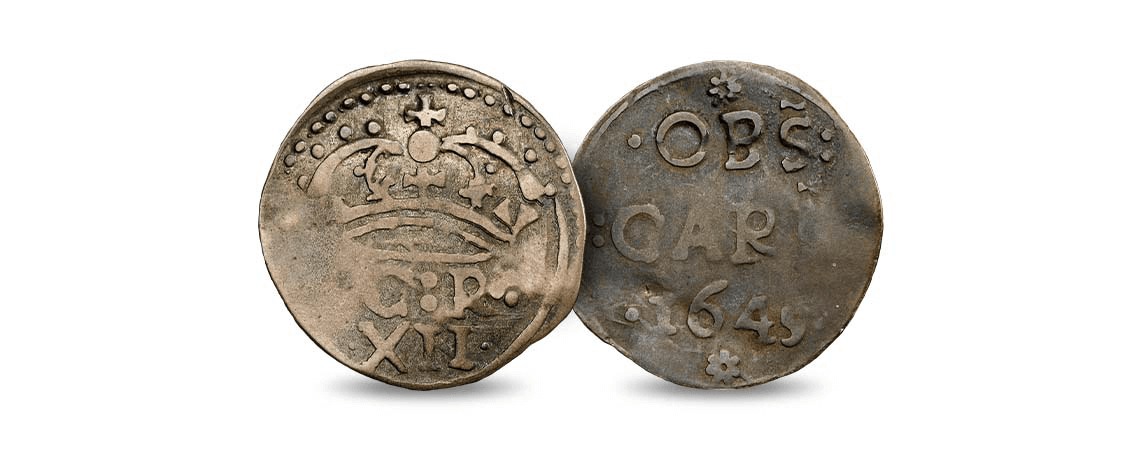
Under Siege
Isolation necessitates improvisation and siege tactics advanced significantly during the sixteenth and seventeenth centuries. With nothing allowed in or out of a town or castle, ways had to be found to maintain everyday economic activity. During the English Civil War, Carlisle became an isolated Royalist outpost in the north of England. When the city was besieged by a Scottish army from October 1644, every citizen was asked to offer up their silver plate to be coined. Siege pieces are often square or diamond shaped and, without access to minting tools, it was easier to cut these patterns from whatever precious metal was available.
Similarly, Royalist strongholds that became cut off from newly established regional mints still needed to pay garrisons to ensure their continued commitment. At Newark, Scarborough, Carlisle and Pontefract, improvised money was produced. Rough-hewn in nature, some of the source material was domestic silverware.
Spoils of War
Conversely, war can provide access to bullion that isn’t normally available. In medieval times a country would pay to secure the release of a captured monarch in its own currency, only to find it melted down to make coins of the opposing territory.
In 1194, Richard I (1189–99) paid a substantial weight of silver coins to Duke Leopold V of Austria to buy his freedom. The Austrian leader went on to strike coins from the coin, which, it is claimed, led to the founding of the Austrian Mint.
Edward III (1327–77) was successful in extracting large ransoms from, amongst others, John II of France and David II of Scotland. It seems a small element was melted down to be made into English coins.
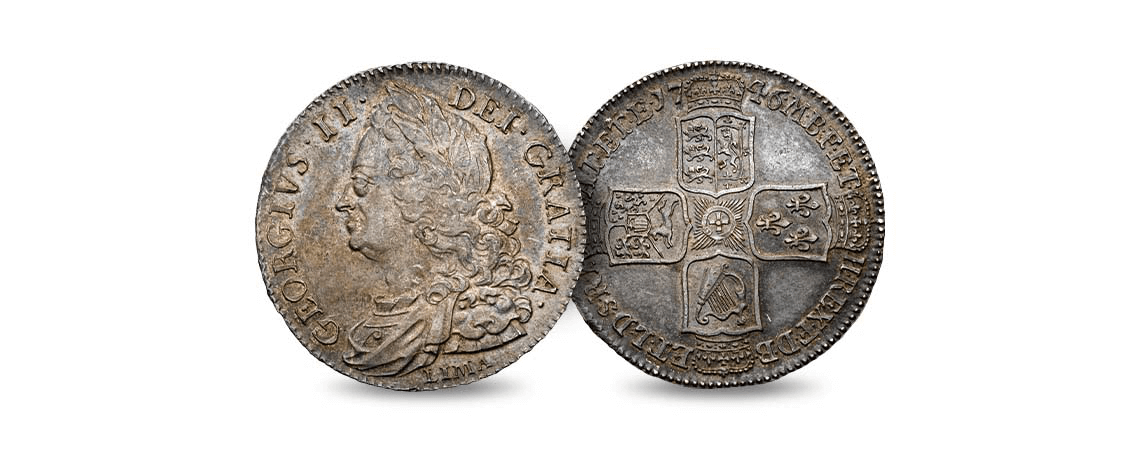
Lima
Captured bullion can also bolster the supply of precious metals. One of the most famous examples is the George II silver shillings of 1745 and 1746, with their inscription 'Lima’ revealing their origin – silver mines located near the Peruvian capital. The consignment came into British hands thanks to the exploits of Commodore George Anson RN, one of the Royal Navy’s greatest commanders.
Tasked with raiding Spanish possessions in the Pacific in a bid to disrupt trade, Anson sent sail from England in September 1740 with a squadron of eight ships. Despite some small gains, the mission was a disappointment. Half of Anson’s fleet were lost or forced to return home and most of his men had died. Undeterred, he resolved to make one final attempt to capture a Spanish Galleon.
Anson’s gamble paid off when the Galleon Neustra Señora de Covadonga was spied sailing for Manila – she was no match for the superior British warship. Boarding the captured vessel, Anson and his crew discovered a huge hoard of silver, including more than 1,300,000 Spanish reale 'pieces of eight' and a further 35,000 ounces of silver bullion. On his return in June 1744, crowds gathered in London to watch the captured loot rolling past in wagons on its way to The Royal Mint.
Vigo
In 1702, after failing to capture the Spanish port of Cadiz, Admiral Sir George Rooke received news that a Spanish treasure fleet had entered Vigo Bay. Rather than return home empty-handed, he ordered a daring raid. All of the French ships were destroyed along with Spanish treasure galleons but, unlike Anson’s haul, the spoils were disappointing. Most of the gold and silver had already been offloaded.
When the fleet returned, some of the looted treasure was handed to The Royal Mint. In June 1703, Master of the Mint Isaac Newton noted the paltry amount: 4,504 pounds of silver and seven and a half pounds of gold. Turning it into coins presented a propaganda opportunity to reassure the public that the war was going well.
It is estimated around 20 coins were struck from the gold seized during the battle and they would have commanded a huge price tag at the time. The coins bear the distinctive ‘VIGO’ hallmark, the result of a royal warrant issued by Queen Anne so as to ‘Continue to Posterity the Remembrance of that Glorious Action’ at Vigo Bay.
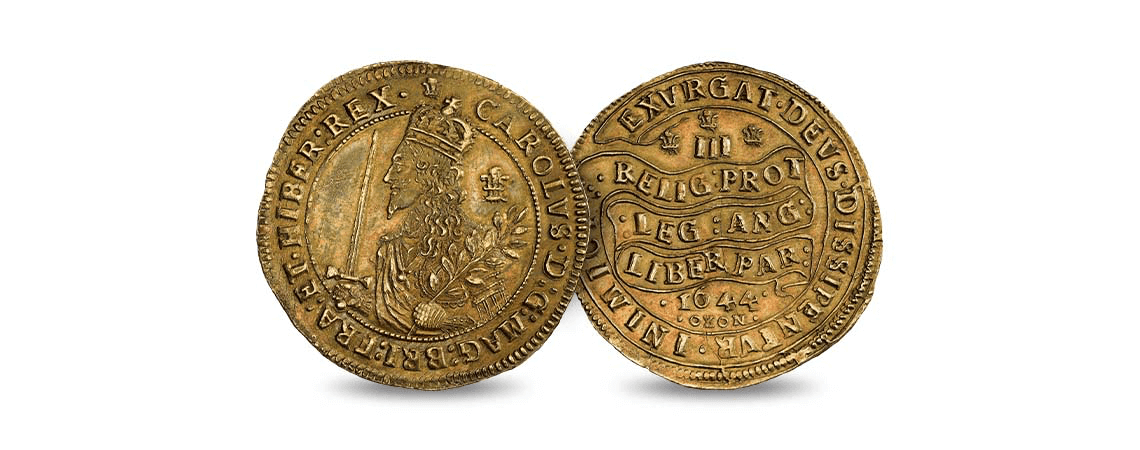
Hearts and Minds
In the battle for hearts and minds during a time of conflict prior to national media, coins offered a means to spread propaganda messages. During the English Civil War, the Royalist mint in Oxford produced elaborate gold triple unite coins which suggests that Charles I was keen to promote the ongoing prestige of his kingship. They were probably made from melted down gold chains of office and jewellery. Images of these impressive coins appeared in a Royalist pamphlet, named A Warning Piece, adding further credence to the theory that they were issued as much for public relations as currency.

Charles I certainly used his coinage to increase his image as a defender of the people and the faith. He is portrayed on horseback, trampling military arms underfoot. Underscoring the imagery, the coins issued in his name are inscribed with a shortened version of the ‘Declaration’ that he made in Wellington in September 1642, promising to uphold the Protestant religion, the Laws of England and the Liberty of Parliament. This statement was slightly at odds with the promises he had made other Catholic foreign monarchs such Louis XIII of France who wanted the religious restrictions of Britain relaxed.
Security and Safekeeping
Facing the threat of invasion, governments must safeguard their supplies of bullion, shipping them overseas for safekeeping if necessary.
Operation Fish
During the Second World War extraordinary efforts were expended on arranging for gold and currency reserves from several European countries to be shipped, in the strictest secrecy, across the Atlantic. By keeping gold from falling into enemy hands the Allies hoped to continue to fund the war even in the event of an invasion. Known as Operation Fish, in the first six months of the war Britain transported more than 100 tonnes of gold to Canada for safekeeping.
Coin Hoards
In the event of an opposing army coming over the horizon, individual stores of wealth were also vulnerable. There were no high street banks where coins could be deposited for safekeeping. From classical times to the twenty-first century, people across the entire spectrum of society have stored valuables in hoards to be retrieved when peace returns.
The diarist Samuel Pepys notes one such incident. On 13 June 1667, fearing imminent invasion as Dutch ships sailed up the Medway, he had his wife and father bury about £1,300 in gold coins at his country house in Brampton, Cambridgeshire. Some days later he fell out with his wife on account of how badly she had hidden them in the garden. However, it wasn’t until 10 October that he set about digging them up.
This wasn’t the first time Pepys resorted to these measures. The previous year he buried a hoard including wine and parmesan cheese as well as gold in his garden in London as the Great Fire advanced.
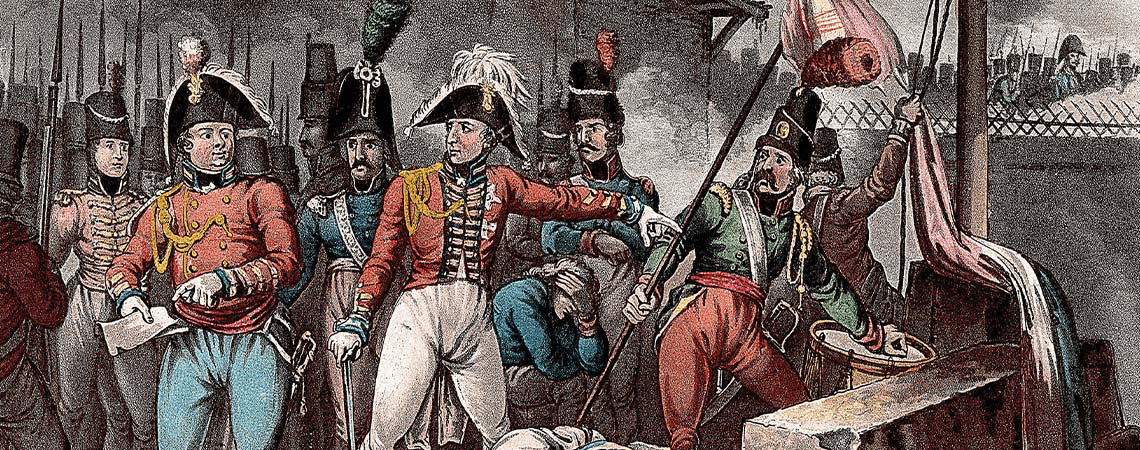
On the March
Financing campaigns overseas impacted coin production in different ways. The Peninsular War (1808–14) between Bourbon Spain and Portugal, assisted by Britain, and the occupying forces of the First French Empire was a catalyst for the return of the large-scale minting of gold coins in Britain. Dated 1813, these coins came to be known as the military guinea because they were shipped to the Duke of Wellington for use in the Iberian Peninsula. These were the last guineas to be struck and about 360,000 were produced in total.
On occasion, war necessitated the production of coins of other states. In 1815, The Royal Mint made French Louis d’Or twenty-franc gold coins to supply to British troops across the channel. The government stressed they were official, claiming approval by the exiled Louis XVIII, but French authorities saw things differently, insinuating they had not been made to the correct standard.
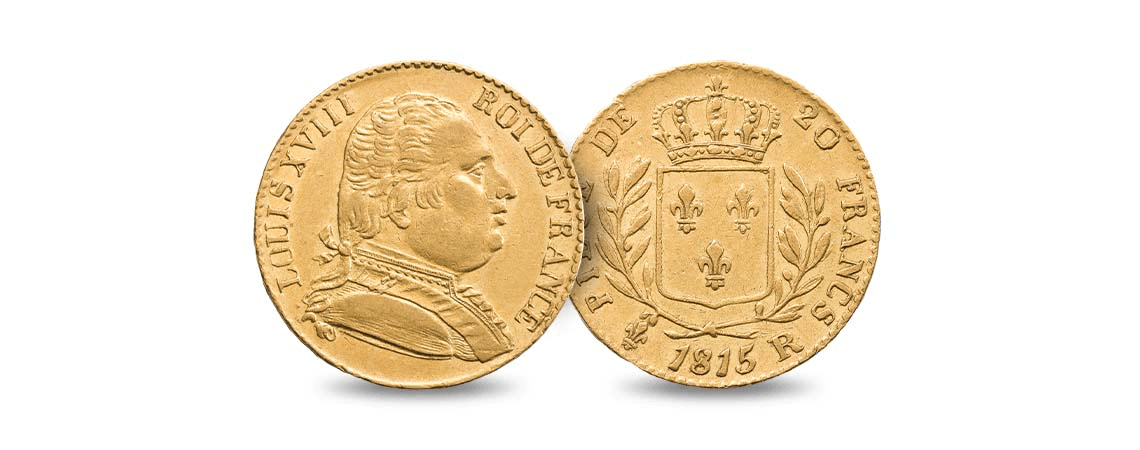
Silver Thaler
Maria Theresa (1740–80) was the only female ruler of the Hapsburg dominions. During her reign the Austrian Mint started striking a popular trade coin: the silver thaler. Like The Sovereign in the Middle East, the silver thaler was an accepted form of payment across North Africa during the nineteenth and twentieth centuries.
When Mussolini invaded Abyssinia in 1935, the Italians need thalers to pay their way through the region. Hitler had annexed Austria and was able to seize the dies from the Austrian mint and send them to his Italian ally, allowing Mussolini’s army to produce the coins they needed.
This was a time of growing international tension. Britain also had interests in the region and needed thalers for the same reason. The Royal Mint was able to copy the dies to create their own coins and production of the ostensibly Austrian thaler carried on in London until the early 1960s.
Footing the Bill
War is often a catalyst for currency reform and the years leading up to the First World War were a golden age for The Sovereign. A model of mass-produced accuracy, its proliferation across the British Empire earned The Sovereign the moniker ‘chief coin of the world’. But, reputation alone couldn’t save it as a circulating coin.
The outbreak of hostilities meant every ounce of gold was needed to pay off debt, build up reserves and finance the war effort. This prompted the government to ask people to hand in their Sovereigns and Prime Minister David Lloyd George’s patriotic plea was heeded. By 1915, gold was no longer part of everyday coinage in London. The Sovereign was replaced by a one-pound note and the Half-Sovereign by a note worth ten shillings.
In 1913, 24,539,672 Sovereigns were struck at The Royal Mint in London. By 1917 this number had dropped to just 1,014,714 and by 1918 it was zero. Despite the demands of the war effort, the exacting production standards of these wartime Sovereigns remained resolutely consistent.
Aftermath
The aftermath of war is accompanied by a multitude of financial pressures: assimilating troops back into civilian life, rebuilding damaged cities and repaying loans taken out to finance the conflict. The true cost comes afterwards, sometimes with big shocks to coinage.
Along with The Sovereign, Britain’s silver coinage was also a victim of the First World War. Higher metal prices after the war meant that from 1920 the amount of silver was reduced from the centuries-old 925 sterling standard to an alloy containing only 500 parts to every 1,000. A point had been reached in the ascent of the price of silver where the bullion value was higher than the face value – something had to give. Changing the silver content of coins didn’t always go according to plan and members of the public reported coins exhibiting unusual colours.
Soon after the Second World War, the use of silver in British coinage was abandoned altogether when The Royal Mint replaced it with cupro-nickel in 1947. With the United States calling in war loans, 88 million ounces of silver was taken out of the nation’s pockets to help fund repayments.
Currency Undercover
Financing war sometimes requires secrecy and subterfuge to ensure sources of funding can be maintained. During the Napoleonic Wars, the British government worked covertly with the Rothschild banking family to help its war effort. Gold and silver coins from across the world were collected by the family in order to finance 20 years of war against France, which ended at the Battle of Waterloo.
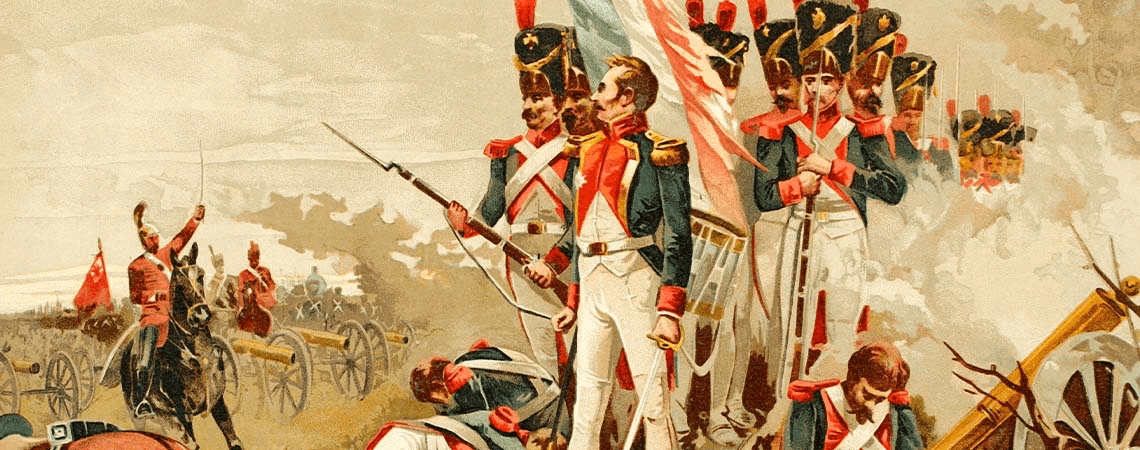
Coins of Nathan Rothschild
Nathan Rothschild had agents across the world who supplied local currency via trading ships and lent to the British government. Coins from far and wide poured into England to pay the wages of the British soldiers and Nathan Rothschild kept a sample coin from each of these shipments.
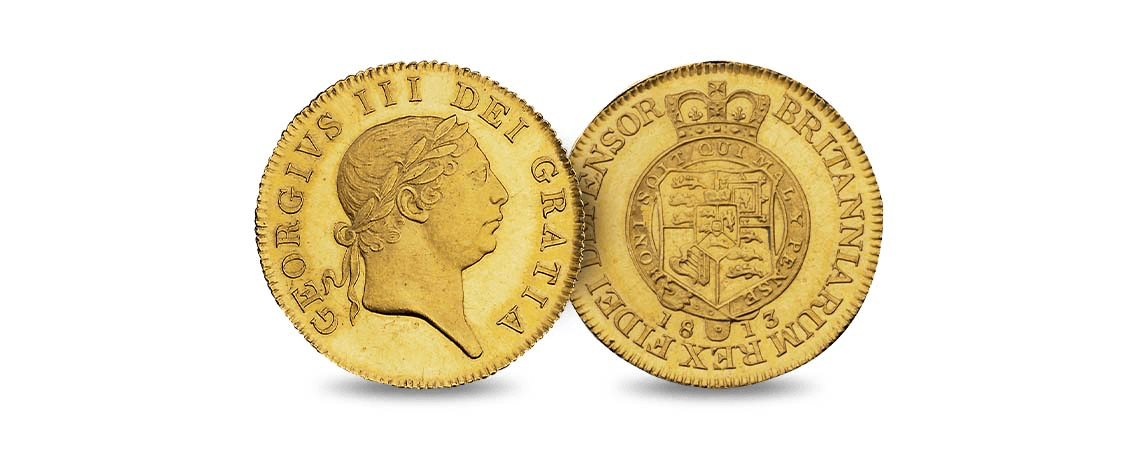
First World War Sovereigns
Hugh Carson Andrews, a clerk at the Bank of England, was unexpectedly called upon to assist with top secret missions during the First World War. He accompanied several shipments of gold Sovereigns from the Bank of England to Amsterdam, in order to support the Dutch Exchange, and to New York, to fund the expenses of war.
The value of the shipments and the threat of German submarine attacks required absolute secrecy. Andrews carried letters of introduction with his signature to verify his identity to the agents he met in the Netherlands and United States.
Behind Enemy Lines
Behind enemy lines, cash has been the preferred method of payment for military personnel and those working undercover. Trusted as a form of universal payment on account of its global reputation, British operatives, secret agents and members of the armed forces have been issued with gold Sovereigns in case of an emergency. These coins provide vital bargaining power in hostile situations and Sovereigns were used during the Gulf War in 1991, mainly by Royal Air Force (RAF) crews shot down over enemy territory.
From Russia With Love
Inspired by his experience in Naval Intelligence during the Second World War, Ian Fleming wove what he encountered into aspects of the James Bond stories. As a result, gold Sovereigns appear in Bond adventures as part of the agent’s kit.
In the 1963 Bond film From Russia With Love, James Bond, portrayed by Sean Connery, is issued with a black leather attaché case by Q Branch – although this was no ordinary case. Stowed away in secret compartments were 40 rounds of ammunition, a throwing knife and ‘in case hard cash was needed’ 50 gold Sovereigns hidden in the lining.
